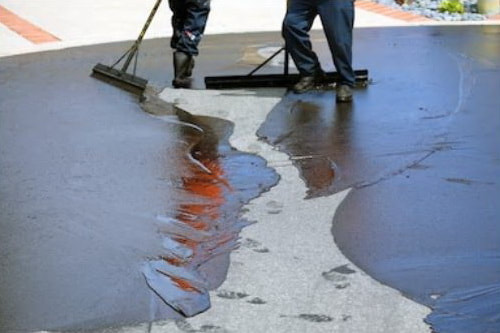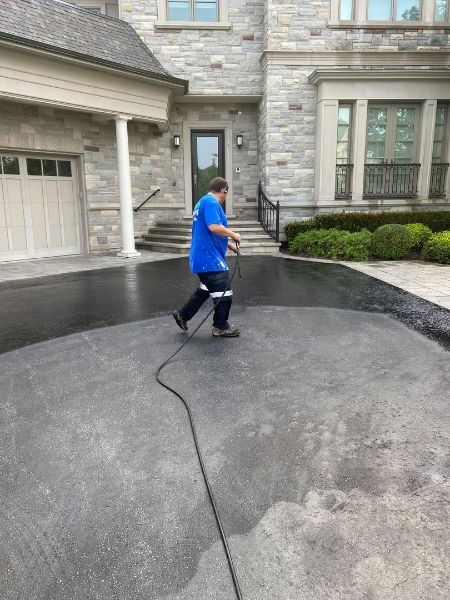Optimize Toughness: Warm Mix Asphalt Sealing for Angled Parking Frameworks
Wiki Article
Hot Mix Asphalt: A Lasting Service for Sidewalk
Hot Mix Asphalt (HMA) has actually emerged as a leading sustainable choice for pavement solutions, using a myriad of ingenious technologies and environmental advantages. Its ability to recycle products and lower power consumption offers an engaging instance for its fostering in road construction projects. Additionally, the lasting efficiency and sturdiness of HMA make it a favored option for infrastructure development. As the demand for environment-friendly building practices expands, discovering the nuances of HMA's sustainability can offer important insights into the future of pavement services.Environmental Advantages of Warm Mix Asphalt

Additionally, Warm Mix Asphalt aids to minimize metropolitan heat island impacts. Its dark shade soaks up sunshine, lowering the amount of warmth reflected back into the atmosphere contrasted to lighter-colored sidewalks. This can lower ambient temperatures in urban areas, decreasing the need for a/c and inevitably minimizing power consumption.
On top of that, Hot Mix Asphalt contributes to boosted stormwater monitoring. Its permeable nature enables water to infiltrate the sidewalk and charge groundwater products, lowering drainage and the danger of flooding. These ecological benefits make Warm Mix Asphalt a lasting choice for leading roads and freeways.
Energy Efficiency in HMA Production
Is energy effectiveness an essential element in the production of Warm Mix Asphalt (HMA)? Energy plays a significant role in the manufacturing of HMA, influencing both expense and environmental sustainability. One essential element of power performance in HMA manufacturing is the use of cozy mix asphalt (WMA) modern technologies.Furthermore, innovations in plant modern technologies have led to even more energy-efficient HMA manufacturing processes. By enhancing power usage in HMA production, the sector can reduce its carbon footprint while keeping high-quality sidewalk products.
Recyclability of Hot Mix Asphalt
The recyclability of Hot Mix Asphalt (HMA) is an essential facet of its sustainability and lasting environmental effect. HMA is just one of the most recycled materials in the United States, with over 100 million lots of recovered asphalt sidewalk (RAP) being recycled annually in new pavement construction. Reusing HMA provides numerous ecological advantages, such as lowering the need for virgin products, decreasing power intake throughout manufacturing, and lowering the quantity of waste sent to landfills.The process of reusing HMA involves milling the existing pavement, squashing it right into smaller items, and mixing it with brand-new accumulation and asphalt binder to produce a recycled mix. In general, the recyclability of HMA plays a significant role in promoting lasting practices within the sidewalk market.

Long-Term Efficiency of HMA
Asphalt sidewalks demonstrate sturdiness and resilience over a prolonged period, reflecting the long-term performance of Hot Mix Asphalt (HMA) The durability of HMA can be credited to its capability to stand up to rush hour tons, extreme weather, and the impacts of aging. Research studies have actually revealed that properly designed and effectively created HMA sidewalks can last for twenty years or even more with routine maintenance. The secret to optimizing the long-lasting performance of HMA depends on utilizing top notch materials, following best techniques in building and construction, and executing efficient maintenance strategies. Correct drain, routine assessments, and timely repairs are essential for maintaining the architectural stability of HMA pavements in time. Additionally, advancements in HMA modern technology, such as the usage of polymer-modified binders and warm mix asphalt, have actually additionally improved the resilience and longevity of HMA sidewalks. By prioritizing top quality building and maintenance techniques, HMA continues to prove itself as visit homepage a cost-effective and lasting service for long-lasting sidewalk infrastructure.
HMA: Sturdiness and Sustainability
Showing both sturdiness and sustainability, Hot Mix Asphalt (HMA) has actually become a cornerstone in the building and construction of lasting sidewalk facilities - commercial parking lot paving. HMA's resilience originates from its capability to withstand hefty lots, severe climate condition, and high traffic quantities, making it a reputable choice for streets, freeways, and flight terminal runways. The make-up of HMA, which generally consists of aggregates, binder, and filler, plays a critical role in improving its durability and resistance to damage
Furthermore, HMA's sustainability depends on its recyclability and energy-efficient manufacturing process. The capability to reuse reclaimed asphalt pavement (RAP) in brand-new HMA mixtures decreases the need for virgin products and minimizes the ecological impact of pavement building and upkeep. Additionally, the power efficiency of creating HMA exists in its reduced blending temperatures compared to other sidewalk products, bring about reduced energy usage and greenhouse gas discharges.
Verdict
Finally, hot mix asphalt (HMA) uses a lasting remedy for sidewalk with its environmentally friendly qualities. HMA's recyclability, energy effectiveness in production, and long-lasting toughness make it an eco-friendly option for roadway building. By saving natural deposits, minimizing waste, and reducing greenhouse gas exhausts, HMA plays an essential function in advertising sustainability in infrastructure advancement. Its ability to reduce city warm island effects even more underscores its importance in developing ecologically conscious and resilient sidewalk systems.
HMA is one of the most recycled materials in the United States, with over 100 million lots of reclaimed asphalt pavement (RAP) being reused every year in brand-new pavement building.The procedure of reusing HMA includes crushing the existing sidewalk, squashing it into smaller sized items, and blending it with brand-new aggregate have a peek at these guys and asphalt binder to produce a recycled mix.Asphalt pavements show resilience and strength over a prolonged period, mirroring the lasting efficiency of Warm Mix Asphalt (HMA) In addition, improvements in HMA innovation, such as browse this site the usage of polymer-modified binders and cozy mix asphalt, have even more enhanced the toughness and long life of HMA pavements. The capability to reuse redeemed asphalt pavement (RAP) in brand-new HMA blends lowers the need for virgin products and reduces the environmental influence of pavement construction and upkeep.
Report this wiki page